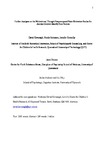The revised four-factor motivational thought frequency and state motivation scales for alcohol control
| dc.contributor.author | Kavanagh, DJ | |
| dc.contributor.author | Robinson, N | |
| dc.contributor.author | Connolly, J | |
| dc.contributor.author | Connor, J | |
| dc.contributor.author | Andrade, Jackie | |
| dc.contributor.author | May, Jon | |
| dc.date.accessioned | 2018-05-29T10:04:32Z | |
| dc.date.issued | 2018-12 | |
| dc.identifier.issn | 0306-4603 | |
| dc.identifier.issn | 1873-6327 | |
| dc.identifier.uri | http://hdl.handle.net/10026.1/11603 | |
| dc.description.abstract |
INTRODUCTION: Elaborated Intrusion (EI) Theory holds that both functional and dysfunctional motivational cognitions are characterized by their intensity, cognitive availability and involvement of imagery, and can be assessed in terms of their frequency and cross-sectional nature. Recently published data on the Motivational Thought Frequency (MTF-A) and State Motivation (SM-A) scales for alcohol control, which were based on EI theory, have shown acceptable fit for a three-subscale structure (Intensity, Imagery, Availability). However, subsequent analyses on the MTF's adaptation to diabetic regimen adherence suggested superior fit from a four-factor model, splitting Imagery into Incentives and Self-Efficacy Imagery. The current paper reanalyzed data on the MTF-A and SM-A, including an additional item on each and using a more robust statistical approach. METHODS: Participants (n = 504) reporting recent high-risk drinking or were currently trying to control alcohol consumption volunteered to complete an online survey that included the MTF-A, SM-A, Alcohol Use Disorders Identification Test and Readiness to Change Questionnaire. Confirmatory factor analyses employed robust maximum likelihood (MLR) with Yuan-Bentler χ2 adjustment, and presented internal consistencies using omega. RESULTS: After omission of multivariate outliers, SM-A data were available from 399 participants, and MTF-A data from 351. Better fit was found for the four-factor model on both measures, and high internal consistencies were obtained for all subscales. Incentives Imagery and Self-Efficacy Imagery were both associated with greater alcohol problems and readiness to change. CONCLUSIONS: The four-factor structures are statistically superior and more theoretically coherent, and allow a focused assessment of key targets of motivational interventions. | |
| dc.format.extent | 69-73 | |
| dc.format.medium | Print-Electronic | |
| dc.language | en | |
| dc.language.iso | en | |
| dc.publisher | Elsevier | |
| dc.subject | Motivation | |
| dc.subject | Desire | |
| dc.subject | Assessment | |
| dc.subject | Confirmatory factor analysis | |
| dc.subject | Alcohol | |
| dc.subject | Alcohol abuse | |
| dc.title | The revised four-factor motivational thought frequency and state motivation scales for alcohol control | |
| dc.type | journal-article | |
| dc.type | Journal Article | |
| dc.type | Research Support, Non-U.S. Gov't | |
| plymouth.author-url | https://www.webofscience.com/api/gateway?GWVersion=2&SrcApp=PARTNER_APP&SrcAuth=LinksAMR&KeyUT=WOS:000445719100010&DestLinkType=FullRecord&DestApp=ALL_WOS&UsrCustomerID=11bb513d99f797142bcfeffcc58ea008 | |
| plymouth.volume | 87 | |
| plymouth.publication-status | Published | |
| plymouth.journal | Addictive Behaviors | |
| dc.identifier.doi | 10.1016/j.addbeh.2018.05.026 | |
| plymouth.organisational-group | /Plymouth | |
| plymouth.organisational-group | /Plymouth/Admin Group - REF | |
| plymouth.organisational-group | /Plymouth/Admin Group - REF/REF Admin Group - FoH | |
| plymouth.organisational-group | /Plymouth/Faculty of Health | |
| plymouth.organisational-group | /Plymouth/Faculty of Health/School of Psychology | |
| plymouth.organisational-group | /Plymouth/REF 2021 Researchers by UoA | |
| plymouth.organisational-group | /Plymouth/REF 2021 Researchers by UoA/UoA04 Psychology, Psychiatry and Neuroscience | |
| plymouth.organisational-group | /Plymouth/REF 2021 Researchers by UoA/UoA04 Psychology, Psychiatry and Neuroscience/UoA04 REF peer reviewers | |
| plymouth.organisational-group | /Plymouth/Research Groups | |
| plymouth.organisational-group | /Plymouth/Research Groups/Centre for Brain, Cognition and Behaviour (CBCB) | |
| plymouth.organisational-group | /Plymouth/Research Groups/Centre for Brain, Cognition and Behaviour (CBCB)/Behaviour | |
| plymouth.organisational-group | /Plymouth/Research Groups/Centre for Brain, Cognition and Behaviour (CBCB)/Cognition | |
| plymouth.organisational-group | /Plymouth/Research Groups/Institute of Health and Community | |
| plymouth.organisational-group | /Plymouth/Research Groups/Plymouth Institute of Health and Care Research (PIHR) | |
| plymouth.organisational-group | /Plymouth/Users by role | |
| plymouth.organisational-group | /Plymouth/Users by role/Academics | |
| dc.publisher.place | England | |
| dcterms.dateAccepted | 2018-05-27 | |
| dc.rights.embargodate | 2019-11-28 | |
| dc.identifier.eissn | 1873-6327 | |
| dc.rights.embargoperiod | 12 months | |
| rioxxterms.versionofrecord | 10.1016/j.addbeh.2018.05.026 | |
| rioxxterms.licenseref.uri | http://www.rioxx.net/licenses/under-embargo-all-rights-reserved | |
| rioxxterms.licenseref.startdate | 2018-12 | |
| rioxxterms.type | Journal Article/Review |


